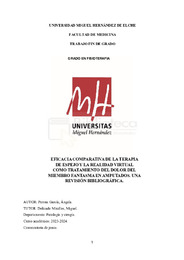Please use this identifier to cite or link to this item:
https://hdl.handle.net/11000/33673Full metadata record
| DC Field | Value | Language |
|---|---|---|
| dc.contributor.advisor | Delicado Miralles, Miguel | - |
| dc.contributor.author | Perona García, Ángela | - |
| dc.contributor.other | Departamentos de la UMH::Patología y Cirugía | es_ES |
| dc.date.accessioned | 2024-10-25T11:52:55Z | - |
| dc.date.available | 2024-10-25T11:52:55Z | - |
| dc.date.created | 2024-05-27 | - |
| dc.identifier.uri | https://hdl.handle.net/11000/33673 | - |
| dc.description.abstract | Introducción El dolor del miembro fantasma (PLP, de sus siglas en inglés Phantom Limb Pain) se define como la percepción dolorosa de una extremidad amputada. Afecta al 50-80% de la población amputada y en muchos casos puede cronificarse afectando a la calidad de vida y al bienestar psicológico. La complejidad del PLP y la falta de investigación limita la optimización de su manejo. Objetivos Comparar la efectividad de la terapia de espejo (TE) y la terapia de realidad virtual (RV) en la reducción del PLP en sujetos amputados. Materiales y Métodos Se realizaron dos búsquedas bibliográficas en distintas bases de datos (Pubmed, Scielo, PEDro, Scopus, BVS y Web of Science) y se incluyeron ensayos clínicos controlados que abordaran el PLP en amputados mediante TE o RV. Además, se evaluó la calidad metodológica de los ensayos. Resultados De trece estudios incluidos, doce aplicaron TE y uno RV. La variable principal fue la intensidad del dolor y como medidas secundarias se incluyeron la calidad de vida y el estado psicológico. En diez de los trece estudios, la TE mostró una reducción significativa del dolor y una mejora en la calidad de vida. El único trabajo de RV redujo simplemente el dolor. Conclusión La TE es una terapia prometedora para el tratamiento del PLP. Por el contrario, no disponemos de suficiente evidencia sobre la RV para extraer conclusiones. Por lo tanto, la falta de investigación sobre la RV ha provocado que la TE sea el método de elección debido a su sencillez y bajo costo. Palabras claves | es_ES |
| dc.description.abstract | Introduction Phantom limb pain (PLP) is defined as the painful sensation of an amputated limb. It affects 50-80% of the amputee population and in many cases can become chronic, affecting life quality and psychological well-being. The complexity of PLP and the lack of research limit the optimisation of its management. Objectives To compare the effectiveness of mirror therapy (MT) and virtual reality (VR) in the reduction of PLP on amputees. Material and Methods Two bibliographic searches of different databases (Pubmed, Scielo, PEDro, Scopus, BVS and Web of Science) were performed and controlled clinical trials addressing PLP in amputees using MT or VR were included. In addition, the methodological quality of the trials was assessed. Results Of thirteen included studies, twelve applied MT and one applied VR. The primary measure was pain intensity, life quality and psychological state were included as secondary measures. In ten of the thirteen studies, MT showed a significant reduction in pain and an improvement on life quality. Just the VR study reduced only the pain. Conclusions MT is a promising therapy for the treatment of PLP. In contrast, we do not have enough evidence on VR to draw conclusions. The lack of research on VR has therefore made MT the method of choice due to its simplicity and low cost. | es_ES |
| dc.format | application/pdf | es_ES |
| dc.format.extent | 35 | es_ES |
| dc.language.iso | spa | es_ES |
| dc.publisher | Universidad Miguel Hernández | es_ES |
| dc.rights | info:eu-repo/semantics/openAccess | es_ES |
| dc.rights.uri | http://creativecommons.org/licenses/by-nc-nd/4.0/ | * |
| dc.subject | Dolor del miembro fantasma | es_ES |
| dc.subject | Amputados | es_ES |
| dc.subject | Terapia de espejo | es_ES |
| dc.subject | Realidad Virtual | es_ES |
| dc.subject | Fisioterapia | es_ES |
| dc.subject.other | CDU::6 - Ciencias aplicadas | es_ES |
| dc.title | Eficacia comparativa de la terapia de espejo y la realidad virtual como tratamiento del dolor del miembro fantasma en amputados. Una revisión bibliográfica | es_ES |
| dc.type | info:eu-repo/semantics/bachelorThesis | es_ES |

View/Open:
TFG PERONA GARCÍA, ÁNGELA.pdf
995,51 kB
Adobe PDF
Share:
.png)
